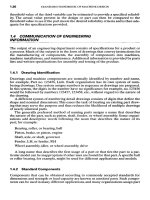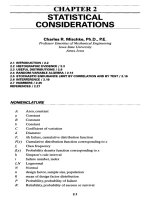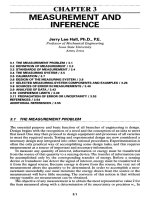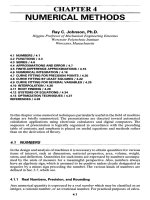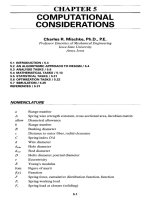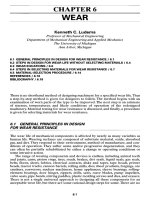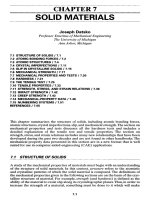Sổ tay tiêu chuẩn thiết kế máy P37 doc
Bạn đang xem bản rút gọn của tài liệu. Xem và tải ngay bản đầy đủ của tài liệu tại đây (1.7 MB, 40 trang )
CHAPTER
31
BELT
DRIVES
Wolfram Funk,
Prof.
Dr lng.
Fachbereich
Maschinenbau
Fachgebiet
Maschinenelemente
und
Getriebetechnik
Universitat
der
Bundeswehr
Hamburg
Hamburg,
Germany
31.1
GENERAL/31.2
31.2
FLAT-BELT
DRIVE/31.14
31.3 V-BELT
DRIVE/31.19
31.4 SYNCHRONOUS-BELT DRIVE
/
31.25
31.5 OTHER
BELT
DRIVES
/
31.35
31.6 COMPARISON
OF
BELT
DRIVES
/
31.37
NOMENCLATURE
A
Cross section
b
Width
Cp
Angular
factor
C
8
Service factor
di
Diameter
of
driving pulley
d
2
Diameter
of
driven pulley
e
Center distance
E
Modulus
of
elasticity
F
Force
f
b
Bending frequency
/
Datum length
of
flexible connector
M
Torque
n
Speed
P
Power
q
Mass
per
length
r
Radius
s
Belt thickness
t
Pitch
v
Velocity
z
Number
a
Included angle
P
Angle
of
wrap
e
Elongation (strain)
(i
Coefficient
of
friction
r|
Efficiency
\j/
Slip
p
Specific mass
a
Stress
Indices
1
Driving
2
Driven
b
Bending
/
Centrifugal
max
Maximum
w
Effective
zul
Allowable
N
Nominal
37.7
GENERAL
Flexible-connector drives
are
simple devices used
to
transmit torques
and
rota-
tional motions
from
one to
another
or to
several other
shafts,
which would usually
be
parallel. Power
is
transmitted
by a
flexible element (flexible connector) placed
on
pulleys,
which
are
mounted
on
these
shafts
to
reduce peripheral forces.
The
trans-
mission
ratios
of
torques
and
speeds
at the
driving
and
driven pulleys
are
deter-
mined
by the
ratio
of
pulley diameters. Peripheral forces
may be
transmitted
by
either frictional (nonpositive)
or
positive locking
of the
flexible
connector
on the
pulleys.
Because
of
their special characteristics,
flexible-connector
drives have
the
fol-
lowing
advantages
and
disadvantages
as
compared with other connector drives:
Advantages:
•
Small amount
of
installation work
•
Small amount
of
maintenance
•
High reliability
•
High peripheral velocities
•
Good adaptability
to the
individual application
• In
some cases, shock-
and
sound-absorbing
• In
some cases, with continuously variable speed (variable-speed belt drive)
Disadvantages:
•
Limited power transmission capacity
•
Limited transmission ratio
per
pulley step
• In
some cases, synchronous power transmission impossible (slip)
• In
some cases, large axle
and
contact forces required
31.1.1
Classification
According
to
Function
According
to
function,
flexible-connector
drives
are
classified
as (1)
nonpositive
and
(2)
positive.
Nonpositive
flexible-connector
drives transmit
the
peripheral force
by
means
of
friction
(mechanical
force
transmission)
from
the
driving pulley
to the flexible
con-
nector
and
from
there
to the
driven
pulley(s).The
transmissible torque depends
on the
friction
coefficient
of the flexible
connector
and the
pulleys
as
well
as on the
surface
pressure
on the
pulley circumference.
The
power transmission capacity limit
of the
drive
is
reached when
the flexible
connector starts
to
slip.
By use of
wedge-shaped
flexible
connectors,
the
surface
pressure
can be
increased, with
shaft
loads remaining
constant,
so
that greater torques
are
transmitted. Since nonpositive
flexible-connector
drives
tend
to
slip, synchronous power transmission
is
impracticable.
The
positive
flexible-connector
drive
transmits
the
peripheral force
by
positive
locking
of
transverse elements (teeth)
on the
connector
and the
pulleys.
The
surface
pressure required
is
small.
The
transmissible torque
is
limited
by the
distribution
of
the
total peripheral
force
to the
individual teeth
in
engagement
and by
their
func-
tional limits.
The
power transmission capacity limit
of the
drive
is
reached when
the
flexible
connector slips. Power transmission
is
slip-free
and
synchronous.
31.1.2
Geometry
The
dimensions
of the
different
components [pulley diameter, center distance,
datum length
(pitch
length)
of the flexible
connector]
and the
operational
charac-
teristics (speed ratio, angle
of
wrap, included angle)
are
directly interrelated.
Two-Pulley
Drives.
For the
standard two-pulley drive,
the
geometry
is
simple (Fig.
31.1).
In
general, this drive
is
designed with
the
center
distance
and the
speed ratio
as
parameters.
The
individual characteristics
are
related
as
follows:
Speed ratio:
/=^
=
£
(31-1)
H
2
(I
1
Included angle:
sina=^-=f
(/-1)
(31.2)
Angles
of
wrap:
P
1
=
180°
-
2ct
=
180°
- 2
arcsin
y-
(i
- 1)
d
(313)
P
2
=
180°
+
2a
=
180°
+ 2
arcsin
-
1
(i - 1)
AiC-
FIGURE
31.1 Two-pulley
drive.
Datum length
of
flexible connector:
I
=
2ecosa
+
n(
dl
^
+
d
2
^)
d
(3L4)
=
2e
cos
a
+^^
[180°
-
2a
+
z(180°
+
2a)]
jOU
Approximate equation:
l
=
2e
+
1.57(d
l
+
d
2
)
+
(d2
-
dlY
d>
(3L5)
=
2e
+
1.57^
1
(I
+ 1)
+-
1
(i
-
I)
2
4^
The
minimum diameter allowable
for the
flexible connector selected
is
often
sub-
stituted
for the
unknown parameter
^
1
(driving-pulley diameter) required
for the
design.
Multiple-Pulley
Drives.
For the
multiple-pulley drive (one driving pulley,
two or
more driven pulleys),
the
geometry
is
dependent
on the
arrangement
of the
pulleys
(Fig. 31.2). These drives have
the
following
characteristics: Speed ratios:
._«i_^2_
-_Z!L_A
•
KI
d
m
h2=
n
2
-d,
'
13
%
3
~
*
hm
'n
m
=
d,
Included angles:
sin
CC
12
=
^-(/
12
-1)
(31.6)
^12
SiDO
13
=
^-(Ii
3
-I)
(31.7)
2^13
FIGURE
31.2
Multiple-pulley drives.
Sin
O
11n
=-T-
1
-
(1I
1n
-I)
(31.8)
^Im
sina,
m
=
-^(/,
m
-l)
(31.9)
2€ton
Angles
of
wrap:
ft
=
180°-OM-X-O
0
+
1
-U
(31.10)
where
7
=
index
of
pulley
Jj
=
angle between
center
distances
,
M^i
M^2
=
~360~
+
^
12
C
°
S
ai2
+
160~
+
^
23
C
°
S
a23
+
'"
+
%^
+
^-
cos
a
km
+
^^
+
^
cos
a
lm
(31.11)
JoU
3oU
31.1.3
Forces
in
Moving Belt
Friction
is
employed
in
transmitting
the
peripheral forces between
the
belt
and the
pulley.
The
relation
of the
friction
coefficient
(i,
the arc of
contact
(3, and the
belt
forces
is
expressed
by
Eytelwein's equation.
For the
extreme case,
i.e.,
slippage along
the
entire
arc of
contact, this equation
is
%">%
For
normal operation
of the
drive without belt slip,
the
peripheral force
is
transmit-
ted
only along
the
active
arc of
contact
$
w
< P
(according
to
Grashof),
resulting
in a
force
ratio between
the
belt sides
of
%">ȣ
<*•*>
The
transmission
of the
peripheral force between
the
belt
and the
pulley then occurs
only
within
the
active
arc of
contact
(3^
with belt creep
at the
driven pulley
and the
corresponding contraction slip
at the
driving pulley. During operation,
the
belt
moves
slip-free along
the
inactive
arc of
contact, then with creep along
the
active
arc
of
contact.
If the
inactive
arc of
contact equals zero,
the
belt
slips
and may run
off
the
pulley.
Along
the
inactive
arc of
contact,
the
angular velocity
in the
neutral plane equals
that
of the
pulley. Along
the
active
arc of
contact,
the
velocity
is
higher
in the
tight
side
of the
belt owing
to
higher tension
in
that side than
in the
slack side. Since this
velocity
difference
has to be
offset,
slip results. This slip leads
to a
speed
difference
between
the
engagement point
and the
delivery point
on
each pulley, which amounts
up
to 2
percent depending
on the
belt material (modulus
of
elasticity),
and
load:
*-
i
f
i
-
ffi
$f
4
-*-
a
i
a
-f
<»•">
For
practical design purposes,
the
calculations
for a
belt drive
are
usually based
on
the
entire
arc of
contact
p of the
smaller pulley
(full
load), since
the
active
arc of
con-
tact
is not
known,
and the
belt slips
at the
smaller pulley
first.
g-—*£
<*•*>
Centrifugal
forces acting along
the
arcs
of
contact reduce
the
surface pressure there.
As
these
forces
are
supported
by the
free
belt
sides,
they
act
uniformly along
the
entire belt:
F
f
=
pv
2
A
=
qv
2
(31.16)
With
increasing belt velocity
v,
constant center distance
e,
and
constant torques,
the
forces
F
1
and
F
2
acting along
the
belt sides
as
well
as the
peripheral force (usable
force)
F
u
remain constant, whereas
the
surface
pressure
and the
usable forces
F{
and
F
2
in the
belt sides
are
reduced. Usable forces
in
belt sides:
Fi
=
F
1
-Ff=mF
2
(31.17)
Fi
=
F
2
-Ff=-
m
Peripheral force:
F
11
=
Fi-Fi
=
F
1
-F
2
=
F[Il-^]
v<
^
<
3118
)
=
F
2
(m
- 1)
FIGURE
31.3
Equilibrium
of
forces.
The
force rating
O
=
-^L
=
(m
-
I)Vm
2
+ 1 - 2m cos p
r
w
defines
the
minimum
shaft
tensioning force required
for
peripheral force produc-
tion
as a
function
of the
friction coefficient
JLI
and the arc of
contact
p.
The
rated output
K =
F
11
/F
{=
1 -
1/ra
defines
the
peripheral force
F
u
which
can be
produced
by the
permissible force
F(
as a
function
of the
friction coefficient
ji
and
the arc of
contact
p. The
reduction
in
rated output with decreasing
arc of
contact
is
defined
by an
angular factor
c
p
,
based
on p =
180°,
that
is, a
speed
ratio
of i = 1.
The
tensions
in a
homogeneous belt result from
the
forces acting
in the
belt
and
the
belt cross section,
A = bs. For
multiple-ply belts, these tensions
can be
used only
as
theoretical mean values.
Because
Fu
=
FKm-I)
m
=
exp^
(31.19)
Pw
becomes greater, until
the
belt slips
on the
pulley with
the
smaller
arc of
contact
when
PH,
= p.
When
Ff=
F
2
,
there
are no
usable forces; that
is,
F
2
=
F(
=
F
M
= O. In
this
case,
no
torque
can be
transmitted.
If
belt velocity
v is
increased further,
the
belt runs
off
the
pulley.
The
maximum force
in the
belt
sides
is
given
by
F^
=
F
1
=
F^
+F
u
+F
f
(31.20)
With
only
the
centrifugal forces acting,
the
belt
is in
equilibrium. They
do not act on
the
pulleys
at
all.
Hence,
the
shaft
load
F
w
of a
belt
drive results from only
the
usable
forces
F{
and
F
2
in the
belt sides (Fig.
31.3):
F
w
= VF? +
F
2
'
2
-
2F№
cos p
(31.21)
Bending
of the
belt around
the
pulley produces
the
bending stress
G
b
.
This stress
can
be
calculated
from
the
elongation
of the
belt
fibers
with respect
to the
neutral
axis:
A/=P(r
+
s)-p(r
+
|)
=
p|
A/
P*/2
s
s
*
=
-=W^)
=
^~^
(
}
c
b
=
zEb~jj
Eb
(31.23)
The
strain
e
increases with decreasing pulley diameter
d. For
practical design pur-
poses,
c
b
is not
taken into consideration, since belt
life
depends much less
on
G
b
than
on the
bending frequency.
The
maximum stress
is in the
tight side
of the
belt
at the
beginning
and end of the
arc of
contact, i.e.,
the
points where
it
passes onto
or
off
the
smaller pulley (Fig.
31.4):
FI
s
CW =
d
I +
Of
+
<5
b
=
— + pv
2
+
E
b
—
(31.24)
The
safety
stress depends
on the
bending
frequency
and the
smallest pulley diame-
ter as
well
as on the
material
and the
construction
of the
belt
as
indicated
by the
manufacturer.
With
z =
number
of
pulleys,
the
bending
frequency
is
given
by
/»=-7-
(31-25)
FIGURE
31.4 Stress distribution.
The
maximum power transmission capacity
of a
belt drive
can be
determined
as
follows:
The
power transmission capacity
P =
F
n
V
=
G
n
Av
equals zero
if the
belt velocity
v
either equals zero
or
reaches
a
maximum
at
which
the
belt
safety
stress limit
is
approached
by the
centrifugal
and
bending stresses
alone,
so
that
oj
=
02
=
O
n
=
O
Then
OZUI
=
o/
+
O
6
=
PvJ
13x
+
O
6
(31.26)
from
which
the
maximum belt velocity
can be
calculated
as
follows:
_
/OzUl-Ok
f3127
v
Vmax-
-J
\DL.£l)
Optimum power transmission
is
possible only
at the
optimum
belt
velocity
v
opt
within
the
range
of v = O and v =
v
max
.
It
depends
on the
belt
safety
stress
and is
given
by
/Ozul
-
Gb
V
max
//21
oc
v
Vopt=
V~3^~
=
V^
(3L28)
In
theory, this equation applies
to all
flexible
connectors, under
the
assumption
of
o
zu
i
(belt
safety
stress)
[or
F
2111
(allowable
load)]
being independent
of
belt velocity.
Since
o
zul
decreases with increasing belt velocity, though,
the
stress
and
power trans-
mission capacity diagrams
are as
shown
in
Fig.
31.5.
31.1.4
Arrangement
and
Tensioning
Devices
Because
of
their good
twistability,
flexible
connectors
are
suited
for
drives with pul-
leys
in
different
planes
and
nonparallel
shafts
of
equal
or
opposite directions
of
rota-
tion.
Since
the
outer
fibers
of a
twisted
flat
belt
or
synchronous belt
are
strained
more than
the
center
fibers,
stress
is
higher there, resulting
in the
reduction
of the
belt power transmission capacity.
Figures
31.6
and
31.7
show several belt drives with pulleys
in
different
planes.
Note that
for
drives with crossed belts (Fig.
31.6),
endless belts have
to be
used,
in
order
to
avoid damage.
For
half-
or
quarter-turn
belt drives (Fig.
31.7),
the
side
of
delivery must
lie in the
plane
of the
mating pulley.
By the use of
step (cone) pulleys,
different
speed ratios
may be
obtained
(Fig.
31.8).
Pulley diameters have
to be
selected
to
ensure equal belt lengths
on all
steps.
The
belt
rim
running onto
the
larger diameter
of a
cone pulley (Fig. 31.9)
has a
higher velocity than
the
opposite
rim. Thus,
the
following
belt portion
is
skewed
and
then runs onto
a
larger diameter.
The
drive
is
balanced when
the
bending moment
due to the
bending deformation
of the
belt
is
compensated
by the
skew
of the
belt
side running
off
(Fig.
31.10).
FIGURE 31.6 Examples
of
crossed belt drives.
FIGURE 31.5 Stress
and
power transmission capacity.
FIGURE 31.7
Belt
drives with
pulleys
in
different
planes.
The
minimum
shaft
tensioning force
F
w
required
for
nonpositive-type force
transmission
can be
produced
as
shown
in
Figs. 31.11
to
31.14.
1.
Pretensioning
by
belt strain:
The
belt
is cut to
such
a
length that
it is
elasti-
cally
preloaded when
it is
placed
on the
pulleys. Since both
the
forces
F in the
belt
sides
and the
shaft
initial tensioning force
are
reduced
by the
action
of
centrifugal
forces,
a/has
to be
added
to the
initial tension
of the
belt
to
ensure proper transmis-
sion
of
peripheral forces
by
friction.
2.
Pretensioning
by
adjustment
of
center
distance:
The
shaft
tensioning force
F
w
is
produced
by
shifting
the
driving motor
on a
slide.
The
belt drive
may be
preloaded
either
by
adjustment
of a
threaded spindle
or by
spring action
or
weighting.
3.
Pretensioning
by
means
of
a
belt tightener acting
on the
slack side:
The
slack
side
of the
belt
is
provided with
a
pulley
to
tighten
it—with
its own
weight
or by
means
of
counterweights
or by
spring
action—and
increase
the
arcs
of
contact
on
FIGURE 31.10 Cone-pulley drive.
FIGURE 31.8 Step pulleys. FIGURE 31.9 Cone pulley.
FIGURE 31.11 Pretensioning
by
belt strain.
FIGURE 31.12 Pretensioning
by
adjustment
of
center distance.
FIGURE 31.13 Pretensioning
with
a
belt tightener.
both
the
driving
and the
driven pulleys.
The
belt tightener produces
a
constant
force
F
2
for all
operating conditions
but
increases
the
bending frequency
f
b
,
thus
reducing
the
safety
stress
of the
belt.
Taking
this into consideration,
we see
that
the
belt tightener used should have
a
minimum diameter equaling that
of
the
smaller pulley,
if
possible.
4.
Pretensioning
by
torque making
use
of
a
rocker
or
pivoting pulley: Fig-
ure
31.14
shows
an
arrangement with
an
eccentric pulley
shaft
pivoting
the
motor
pulley
shaft.
The
pulley
is
driven
by a
gear assembly.
The
shaft
tensioning
force
F
w
increases almost
in
proportion
to the
tooth force
F
z
,
and
with
the
correct
ratio
of
/i
2
/^i,
adapts automatically
to the
specific torque
to be
transmitted. Belt slip-
ping
is
impossible with this method
of
pretensioning.
For all
belt pretensioning methods using tensioning devices which
can be
adjusted
during operation
of the
drive (e.g., methods
2 to 4
described above),
the
shaft
tensioning force
F
w
and the
usable forces
F{
and
F
2
in the
belt sides
are not
influenced
by
centrifugal force. Centrifugal force increases
the
belt stress
by 07,
though.
31.2
FLAT-BELTDRIVE
Calculations
for flat-belt
drives
are
based
on
Eytelwein's
fundamental
equation
of
belt friction:
* >£
<
31
-
2
"
For
calculations
for
a
belt drive,
the arc of
contact
of the
smaller pulley
is
substituted
for
the arc of
contact
p,
since
the
belt slips
at the
smaller pulley
first,
and the
active
arc of
contact
p^
is not
known.
The
transmissible power
P is
calculated
from
the
peripheral forces
Fu
=
F{-Fi
=
F
2
{exp
№•)
-
ll
(31.30)
L
V
i8U
/
J
and
the
belt
velocity
v and is
expressed
by
P
1
=
Vl
F
u
P
2
=
v
2
F
u
(31.31)
The
belt velocities
are
VI
=
TI
nidi
V
2
=
TCn
2
d
2
(31.32)
FIGURE
31.14 Pretensioning
by
torque.
Taking
into consideration
a
service correction factor
C
B
(Table 31.1)
for
peak over-
loads
due to
heavy duty,
we can
calculate
the
power rating
of the
drive
from
P
1
by
P =
C
5
P
1
(31.33)
The
speed ratio, which
is
slightly dependent
on the
load because
of
slip,
is
._*i
_d
2
v,
_
d
2
d
2
n
2
Ci
1
V
2
(I
1
(I-G
n
E)
J
1
(I-Xj/)
In
calculations,
the
approximation
i^
(31.35)
d
1
may
be
used.
The
efficiency
depends
on the
belt slip only, with
the
bearing friction
and
windage
being neglected, since
the
pull
of
either belt side
at
both pulleys must
be
assumed
to
be
equal:
"•K-t-'-f-
1
-"
**>
where
M
1
=
F^
M
2
=
F
11
^-
(31.37)
The
bending frequency, which
is of
particular importance
for
belt
life,
is
calculated
by
/t=y
(31.38)
It
should
not
exceed
the
limit specified
for the
particular belt material.
Modern high-performance
flat
belts
are
designed
as
multiple-ply belts. They con-
sist
of two or
three plies, each serving
a
special purpose. Leather belts made
from
hide
and
Balata
belts
are no
longer used.
In
some cases,
the
improvements
in
power
transmission capacity brought about
by the
development
of
modern high-
performance
flat
belts
are not
fully
utilized
in
standard belt-drive applications.
The
utilization
of a
drive unit
is
influenced
by the
design characteristics
on
which
a
flat-
belt drive
is
based. Thus,
it is
advisable
to
always consider
the
whole
flat-belt
drive
unit
instead
of
just
the flat
belt.
The
major
components
of a
multiple-ply belt
are the
tension
ply and the
friction
ply.
The
purpose
of the
tension
ply is to
absorb
the
forces resulting
from
the
defor-
mation
of the
belt
by
tensioning.
The
energy
stored
by
tensioning
of the
belt
at
min-
imum
elongation
is the
basis
of the
power transmission.
In
addition,
the
tension
ply
has
to
absorb
the
centrifugal forces acting
on the
belt during
operation.
Since
the
materials used
for the
tension
ply do not
have
the
required frictional
characteristics,
a
separate, laminated friction
ply is
used
as the
second
layer.
This
fric-
tion ply, which
is
adapted
to the
operating conditions with regard
to
material
and
surface
finish,
transmits
the
friction
forces
from
the
pulley surface
finish
to the
ten-
sion
ply and
vice versa (Fig.
31.15).
The
tension
ply is
usually made
of
highly drawn
Operating
conditions
Continuous
service,
small
accelerated
masses
Interrupted
service
without
bumps,
medium-
sized
accelerated
masses
Interrupted
service
with
bumps,
medium-
sized
accelerated
masses
Service with
severe
bumps,
large
accelerated
masses
Application
Examples
Liquid-stirring
apparatus,
agitators, calenders
and
drying
equipment
for
paper
manufacture,
setters, slitters
and
folders, centrifugal
pumps
and
compressors,
fans
up to 7.5 kW,
light-
duty
woodworking
machinery,
sifting
plants
Agitators
and
mixers
for
semifluid
media, machine
tools (such
as
grinding,
turning,
drilling
and
milling
machines), punches,
embossing machines,
presses,
textile machinery,
laundry
machinery,
fans
above
7.5
kW,
generators
and
exciters, rotary
presses,
vibrating screens
Elevators
and
worm
conveyors, centrifuges,
paper
manufacturing
machinery such
as
grinding
gear, pumps, shredders,
beaters,
piston pumps
and
compressors,
blowers, high-
power
fans
Crushers
and
rolling mills, ball
mills,
tile-molding
machines,
compressors
and
high-capacity
pumps, hoists
Alternating-current
and
three-phase
motors with
a low
starting torque
(up
to 1.5
times
nominal torque);
dc
shunt
motors;
internal
combustion
engines with eight
or
more cylinders
1.2
1.3
1.5
1.6
Alternating-current
and
three-phase
motors with
moderate starting
torque
(1.5
to
2.
5
times nominal
torque); internal
combustion
engines with
six
cylinders
1.4
1.5
1.7
1.8
Alternating-current
and
three-phase
motors with
high
starting torque
(above
2.5
times
nominal torque);
internal
combustion
engines
with
four
cylinders
or
fewer
1.6
1.7
1.8
1.9
tThe
service
factor
CB
takes
into
account
the
type
of
prime movers
and
driven
machines.
Special
operating
conditions
are not
taken
into account
in
these
values.
The
factors
stated
are
guide values.
TABLE 31.1
Service
Factor
C
B
Prime movers
FIGURE
31.15
Multiple-ply
belt.
polyamide strips
or
polyester cord.
The
friction
ply,
firmly
attached
to the
tension
ply,
is
made
of
either synthetic rubber
or
polyurethane
or
chrome leather. Table
31.2
shows
the
most important physical data
for
high-performance
flat
belts
of the
most
commonly used tension
ply
materials, polyamide
and
polyester.
The
belts
are
manu-
factured
in
endless
form
according
to the
user length requirements
or are
made
end-
less
by
heat-cementing
the two
beveled, feather-edged ends. Table
31.3
shows sizes
of
pulleys
for flat
belt drives
and
tolerances.
Calculations
for a
high-performance belt drive
are
usually based
on
data supplied
by
the
belt manufacturer. Since
the
latest developments
are
always taken into
con-
sideration
in
this information,
use of the
latest manufacturers' data
for the
calcula-
tion
is
mandatory.
TABLE
31.2
Physical Data
of
High-Performance
Flat Belts
Tension
ply
Notion
Tensile
strength
Elongation
at
rupture
Stress
at
1%
elongation
Service
elongation
Specific
nominal
peripherical
force
Specific
nominal
power
P
N
Maximum
belt
velocity
Maximum
tolerable
bending
frequency
Elongation
slip
at
nominal
peripherical
force
Attenuation
(logarithmic
decrement)
tf
Efficiency
77
Total
thickness
a
Belt
width
Belt
length
Unit
N/mm
2
N/cm
%
N/cm
%
N/cm
kW/cm
m/s
1/s
%
mm
mm
mm
Polyamid
450-600
1300-18000
~~
22
30-400
1.5-3.0
40-800
<45
60-80
80-100
-0.8-1.0
-0.28
0.98-0.99
1.0-8.0
Max.
1000
Unlimited
Polyestercord
700-900
1300-6600
-12-15
100-400
1.0-1.5
100-400
<60
80-150
100-250
-0.4-0.6
-0.25
0.985-0.99
0.8-4.0
Max.
450
Max.
12 000
TABLE
31.3 Size
of
Pulleys
for
Flat-Belt Drives
Diameter
d
}
nominal
size
40 50 63 71 80 90 100 112 125
Allowable
off
size
0.5 0.6 0.8 1 1 1.2 1.2 1.2 1.6
Height
of
convexity
0.3 0.3 0.3 0.3 0.3 0.3 0.3 0.3 0.4
Tolerance
of
concentricity
0.2 0.2 0.2 0.2 0.2 0.2 0.2 0.3 0.3
Diameter
</,
nominal
size
140 160 180 200 224 250 280 315 355
Allowable
off
size
1.6 2 2 2 2.5 2.5 3.2 3.2 3.2
Height
of
convexity
0.4 0.5 0.5 0.6 0.6 0.8 0.8 1 1
Tolerance
of
concentricity
0.3 0.3 0.4 0.4 0.4 0.4 0.5 0.5 0.5
In
addition
to the
applicable ratings
of the
various high-performance
flat
belts,
their types,
and
their configurations,
the
following data
are
necessary
for the
calcu-
lations
for a
single-step
flat-belt
drive:
1.
Type
of
prime mover (driving assembly),
e.g.,
electric motor, combustion engine,
water turbine,
etc.;
this
is
important
for the
determination
of the
corresponding
service-correction factors.
2.
Type
of
machine (driven assembly); this determines corresponding load
factors,
dependent
on
acceleration, forces
of
gravity,
changing loads, etc.
3.
Power
to be
transmitted
P, in
kilowatts.
4.
Speed
of
driving pulley
n\,
in
revolutions
per
minute.
5.
Diameter
of the
driving pulley
^
1
,
in
millimeters.
6.
Speed
of the
driven pulley
n
2
,
in
revolutions
per
minute.
7.
Diameter
of the
driven
pulley
^
2
,
in
millimeters.
8.
Center distance
e, in
millimeters.
9.
Adjustment range available
(of
tensioning device).
10.
Allowable radial
shaft
loads
of
prime mover
and
driven assembly, loads
on
which
the
maximum
shaft
tensioning force
F
w
depends.
With
the use of the
above data
and the
manufacturer's data, calculations
for the
flat-belt
drive
can be
made, giving
the
designer
the
type
of
belt, belt width, dynamic
and
static
shaft
stresses,
and the
required elongation, expressed
as the
percentage
of
belt strain.
Because
of the
special characteristics
of flat-belt
drives with high-performance
belts,
the
determination
of the
drive data should
be
based
on the
following:
1. The
belt velocity should
be as
high
as
possible
(v
opt
).
The
higher
the
belt
speed,
the
smaller
the
belt width
and
thus
the
shaft
load.
2. In
calculating drives with changing loads
or
cyclic variations,
you
should determine
to
what extent
the
damping properties
of the
tension
ply
materials
can be
utilized.
3. You
have
to
examine whether
the
initial tension
of the
belt
or the
shaft
load
can
be
accurately calculated
from
belt strain data.
4. The
manufacturer
can
supply belts
of all
widths
and
lengths;
you
should examine,
however, whether there
are
restrictions
from
the
design point
of
view.
5.
Finally,
you
must examine whether
the
belt
can be
manufactured
in
endless
form
or has to be
assembled open-ended, with
the
ends being closed
by
welding
after
assembly.
The
following general guidelines apply
to
pulley design:
1. The
pulleys
for
open
and
crossed
flat-belt
drives
are
crowned
in
accordance with
ISO R 100
(Table 31.3)
in
order
to
align
the
belt, which tends
to
move toward
the
larger pulley diameter.
2. For
speed ratios higher than
1/3 (i > 3), the
smaller pulley
may be
cylindrical. Spa-
tial belt drives
are
equipped with cylindrical pulleys.
3. The
requirements
for
smooth running
of the
belt
are as
follows:
Parallelism
of
both
shafts,
smooth pulley
faces,
static balancing
up to
belt velocities
v of 25
meters
per
second (m/s),
and
dynamic balancing
for
velocities above
25
m/s. When
certain aluminum alloys
are
used, abrasion
may
occur, reducing friction between
belt
and
pulley
to
such
a
degree
as to
make power transmission impossible.
Flat-belt drives
are
nonpositive
flexible-connector
drives used
for the
transmis-
sion
of
forces
and
motions between
two or
more
shafts,
particularly
at
greater center
distances. This type
of
drive
is
superior because
of its
elasticity, enabling
it to
absorb
shock loads,
and its
low-noise running.
Its
disadvantages
are the
greater forces act-
ing
on the
shafts
and
bearings, resulting
from
the
required initial tension,
and the
unavoidable belt slip.
These
properties
are
decisive
for the
preferred applications
of flat-belt
drives,
e.g.,
in
machine tools, textile machinery, mixers
and
grinders, paper machines, gang
saws,
wire-drawing machines, presses, punches,
and
compressors. Flat belts with suit-
able contours
may
also
be
used
as
conveyor belts.
Figure
31.16
shows
the
drive
of a
hobbing machine.
A
high-performance
flat
belt
was
used
in
this case
not
because
of its
efficiency
or
damping properties,
but
because
of
the
uniformity
of
rotational transmission
from
one
pulley
to the
other. Preliminary
studies have shown that even slight transmission deviations
affect
the
dimensional
accuracy
of the
tools manufactured
on
such machines. Belts
for
this application
are
subjected
to a
transmission accuracy test
on a
special test stand before delivery.
Figure 31.17 shows
the
tangential belt drive
of a
textile machine. This drive
of a
ring spinning
frame
is
typical
of a
so-called multipoint drive
or, in
particular,
a
tan-
gential belt drive.
In
this machine,
a
high-performance
flat
belt
of
35-mm
width
and
approximately
82-m
length drives
a
total
of 500
spindles
on
each side
of the
machine.
The
total power
of 25 to 30 kW per
machine side
is
thus distributed
to 500
separate
work
positions. Depending
on the
spindle speed,
the
belt velocity ranges
from
25 to
45
m/s.
The
absolute constancy
of the
belt operating tension throughout
the
life
of
the
drive
is a
necessary prerequisite
for
this type
of
application.
31.3
V-BELTDRIVE
V-belt
drives
are
nonpositive drives.
The
peripheral
force
F
u
is
transmitted
by
fric-
tional forces acting
on the flanks of the
pulley-and-belt
combination (Fig.
31.18).
Bottoming
of the
belt
in the
groove leads
to a
reduction
of the
transmissible periph-
eral
force,
to
belt slip,
and to
damages owing
to
overheating.
FIGURE 31.16 Drive
of a
hobbing machine.
(Siegling.)
FIGURE 31.17 Tangential belt drive
of a
textile machine.
(Siegling.)
FIGURE
31.18 Section
of a
V-belt
and
sheave.
The
known
form
of
Eytelwein's equation cannot
be
used
for the
calculations
for
V-belt drives, since
the
belt creeps
in the
direction
of
travel
and is
simultaneously
pulled
radially into
the
groove
by the
radial component
of the
belt side
force,
with
friction
being reduced
by
this.
Hence
£>-»[(=&>]
<
31
'
3
"
The arc of
contact
(3
of the
smaller pulley
has to be
used
in the
calculation
of a
V-belt
drive.
In
general,
a
belt angle
a on the
order
of 36° is
selected, since
a < 20°
would cause
self-locking.
Such
a
belt would operate with
a lot of
jerking
and
little
efficiency.
By
bending around
the
pulley during operation,
the
belt
is
stretched
on the
outside
and
compressed
on the
inside,
the
belt angle thus being reduced compared
to
that
of the
straight
belt.
The
smaller
the
pulley diameter,
the
larger
the
reduction
of the
belt
angle. Since snug
fit
between belt
and
groove sides
has to be
ensured,
the
groove
angle
must
be
adjusted
accordingly. Incorrect groove angles
will
reduce power trans-
mission capacity
and
belt
life.
The
calculations
for
V-belt drives
are
internationally standardized (ISO
R
155).
In
general,
manufacturers'
supply data
for
the
calculations
for
V-belts
and
other
belt
types,
too,
are as
follows:
Speed
ratio:
i
=
^
=
^-
(31.40)
n
2
d
w
i
For
pulley diameters, standard series have been specified. When these pulley diame-
ters
are
used, standardized speed ratios
will
result. Pulley diameters below
the
min-
imum
values recommended
for the
belt section
in
question should
not be
used
because
the
higher bending stress materially reduces belt
life.
Distance between
shaft
centers:
Recommended lower limit:
e
>
0.1(d
2
+
di)
mm
(31.41)
Recommended upper limit:
e
<
2(d
2
+
d^)
mm
Shaft
center distances that
are too
short (short belts) result
in
high bending fre-
quencies, causing excessive heating
and
thus premature failure
of the
belt.
Shaft
cen-
ter
distances that
are too
long (long belts)
may
result
in
belt vibrations, especially
of
the
slack side, also causing higher belt stress.
Adjustment
of
shaft
center distance (Fig.
31.19):
X
>0№L
W
mm
(31.42)
X
^0.015Lv,
mm
The
importance
of the
adjustability
of the
shaft
center distance
for
tensioning
and
retensioning
of the
belt
(X) as
well
as for
easy application
of the
belt
(Y) is
often
underestimated.
The
quantity
Y in
particular
is
often
neglected, resulting
in
applica-
tion
problems,
and the use of
tools
may
cause belt damage when
the
belt
is
first
applied.
The
transmissible power
of the
belt
is
given
by
P =
2nnM
(31.43)
where
M =
known torque
and n =
speed
of the
corresponding pulley.
Taking into consideration
a
service-correction factor
C
B
(Table
31.1),
we can
cal-
culate
the
power rating
of the
drive
from
P by
P
=
C
8
P
1
(31.44)
FIGURE 31.19
Adjustment
of
shaft
center
distance.
The
calculation
of
belt velocity (peripheral velocity)
is not
really necessary,
as the
power rating tables
are
based
on
pulley diameter
and
speed:
v
=
ndin
k
~nd
2
n
g
(31.45)
For
multiple drives,
the
number
of
V-belts
required
is
calculated
from
<-i&
*
IM>
The arc of
contact factor
Ci,
the
service
factor
C
B
,
and the
belt length correction fac-
tor
C
3
can be
found
in the
manuals
of the
manufacturers.
The
power rating
P
N
of
each
belt—based
on the
selected pitch diameter
d
w
\
of the
smaller pulley,
the
corre-
sponding speed
W
1
,
and the
speed
ratio—can
be
derived
from
tables.
These
tables
also
contain
the
nominal values
of the
service-correction factors
to be
used. When
the
guidelines mentioned
in the
design
of a V
belt
are
observed,
the
belt
life
to be
expected
is 24 000
hours
(h) of
operation.
As for
flat
belts,
the
bending frequency
is
/»=y
(31.47)
Normal bending frequencies
are
f
b
< 30 per
second
for
endless standard V-belts
fb
< 60 per
second
for
endless
narrow-V-belts
The
belts have
to be
pretensioned
to
limit belt slip
to 1
percent. Improperly preten-
sioned belts have
a
life
substantially shorter than
the 24 000 h
mentioned.
The
nec-
essary initial tension
will
lead
to
equivalent
shaft
or
bearing loads.
The
approximate equation
for the
calculation
of the
required average
shaft
ten-
sion
force
is
F
w
=
—
1.5
<
a
<
2
(31.48)
where
P =
power
to be
transmitted
and v -
belt velocity. More accurate methods
may
be
found
in the
manufacturers' publications containing
a
description
of the
correct
initial tension adjustment
by
force
and
deflection measurements
at the
center
of the
belt side.
The
different
belt types
are
distinguished
by
section dimensions;
the
configura-
tions, however,
are
distinguished
by
belt construction. Figure
31.20
shows
the
most
widely
used
V-belt
configurations.
V-belts consist
of the
following
firmly
vulcanized elements:
1.
Intermediate
ply of
high-strength cord (cotton, polyester)
for
transmission
of the
rope-pull force
2.
Highly elastic belt body (rubber, plastic)
for
transmission
of the
peripheral forces
between
the
belt
flanks
and the
cord
ply
FIGURE
31.20
V-belt
configurations.
3.
Impregnated
wear-resisting
fabric
coat (textile fibers)
for
transmission
of the
fric-
tion forces between
the
belt
flanks
and the
V-belt pulley
Because
of its
higher modulus
of
elasticity,
the
cord
ply
forms
both
the
neutral
axis
and the
pitch diameter
d
w
of the
V-belt
in the
groove, i.e., that diameter which
is
relevant
for the
transmission
of
peripheral velocity.
The
endless standard
V-belts
(Fig.
31.2Oa)
in
accordance with
ISO
(ISO
R 52,
R253, R434
and
R606)
are
supplied
in
specified lengths
and
cannot
be
shortened.
Endless
narrow-V-belts
(Fig.
31.2Oc)
in
accordance with
ISO R 459 and R 460 are
most widely used today. Their power transmission capacity
is
higher than that
of
standard V-belts
of the
same pitch width.
FO-type V-belts (Fig.
31.206),
made
by the
Continental
Gummi-Werke
AG, are
distinguished
by
their basically
different
construction. They
are a
promising
new
development superior
to
others
for the
unusually small change
of
length their ten-
sion members undergo when loaded. Transverse short
fibers
in the
rubber
filler
lead
to
high lateral
stiffness
with high
flexibility
in the
direction
of
belt travel.
By
grind-
ing
the
flanks,
the
traveling accuracy
of the
FO-type V-belt
can be
improved system-
atically.
The
Continental belts
of
this type
are
manufactured
as
endless standard
V-belts
of
small section dimensions
and as
endless
narrow-V-belts.
The
flexibility
of the
V-belts
mentioned thus
far may be
increased
by
cross
grooves worked into
the
inner
surface
of the
profile (Fig.
31.2Oe).
These grooved
belts
allow smaller pulley diameters
and
require less space
at
slightly reduced power
transmission capacity than other belts; however,
the
grooves
are the
cause
of
peri-
odic running
in of
shock loads
and
noise.
A
V-belt
assembly (Fig.
31.20/z)
is
composed
of up to
five
standard
or
narrow-
V-belts
connected
by an
elastic cover band which does
not
rest
on the
pulleys.
The
cover band prevents twisting
or
excessive vibration
of
individual belts.
The
grooves
of the
V-belt pulleys
are
standardized (ISO
R 52, R 253 for
standard
V
belts
and ISO R 459 for
narrow-V-belts).
The
pulleys
are
castings
or
weldings
or
steel-plate parts.
In
general, pulley diameters below
the
minimum specified should
not be
used.
The
groove
flanks
must
be
smooth
and
clean
to
ensure
a
sufficiently
long belt
life.
Applications
of
V-belts
are
practically unlimited. Because
of the
variety
of
sec-
tions available,
the
V-belt
may be
used
for
fractional-horsepower drives with mini-
mum
power transmission capacity
in
precision machines, phonographic equipment,
and
domestic appliances;
for
light drives, e.g.,
of
centrifugal
pumps
and
fans;
and for
all
sizes
of
drives
for
general mechanical engineering purposes
up to
heavy-duty
drives, such
as
rolling mill, rock crusher, excavator,
and
crane drives.
In
general,
the
power transmission capacity
is
approximately
700 kW
maximum;
it
may be
increased
to
1000
kW and in
very rare cases
to
approximately 5000
kW.
Because
of the
extreme variety
of
applications
in
mechanical engineering, gen-
eral belt-life data cannot
be
given. Another explanation
is
that belt
life
largely
depends
on the
conditions
of
use. Assembly
and
operating conditions
affect
belt
life,
as
do
environmental conditions such
as
oil, dust,
and
climatic conditions.
The
power transmission capacities specified
in the
relevant standards
are
based
on the
very high empiric
belt
life
of 24 000 h,
which
can be
reached only under opti-
mum
operating conditions, i.e.,
no
misalignment
of the
pulleys,
no
overload, correct
belt
tension, normal ambient conditions, etc.
One of the
particularly important areas
of
V-belt application
is the
automotive
industry
with
its
large primary equipment production series
and
substantial spare-
part need.
The
V-belt
as a
drive unit connects
the
crankshaft
and
different
accessory
units,
e.g., generator,
cooling-water
circulating pump,
and
fan.
The
V-belt
may
also
be
used
for
driving air-conditioning equipment
or
turbosuperchargers.
The
life
of car
V-belts
is
calculated
for a
total distance
of 50 000 to 80 000
kilometers (km).
If
higher power transmission capacities
are
required
in
mechanical engineering,
multiple
drives (Fig.
31.21)
are
used. When used
as
main drives
in
situations involving
high
cost
in
case
of
failure,
such
as
mine
fan
drives
and
drives used
in the
metallurgi-
cal, glass,
and
cement industries, multiple drives also meet
the
demand
for
safety,
since
the
probability
of
sudden
failure
of a
complete belt
set is
very small.
The
uniformity
of
initial tensions
and
speed ratios
of all
belts
of
multiple drives
is a
prerequisite
for
smooth running
and
equal distribution
of
total
power
to all
belts. Differences
in
speed
ratios
and
initial tensions
will
lead
to a
reduction
in
belt
life.
Thus
the
complete
set of
belts should
be
replaced,
if
necessary,
not
just
a
single endless belt.
31.4
SYNCHRONOUS-BELT
DRIVE
The
synchronous belt
is a
relatively
new
machine element combining
the
advantages
of
positive
and
nonpositive
flexible
connectors.
In
contrast
to the
nonpositive belt
drives,
the
pulleys
and
belts
of
synchronous-belt drives have meshing
teeth,
allowing
synchronous
power transmission with angular accuracy (Fig.
31.22).
To
prevent rid-

